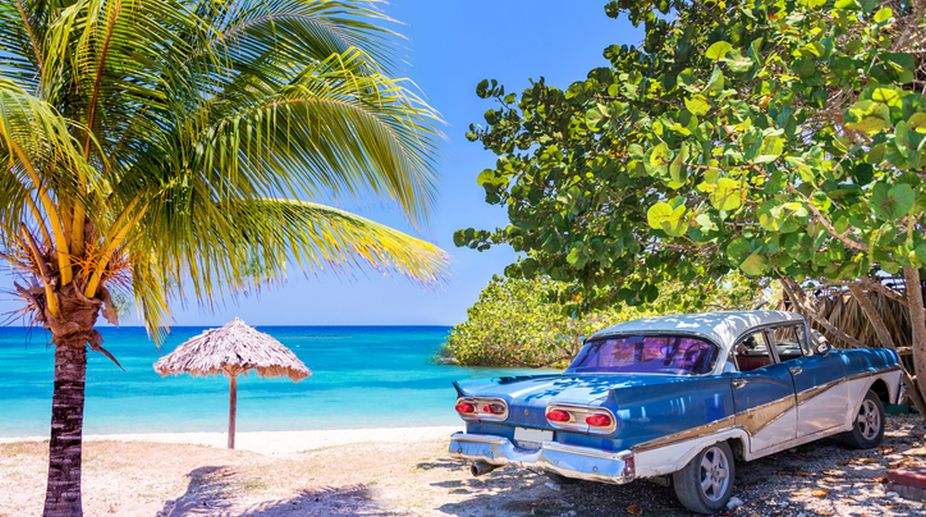Amp up your mixologist game
We all have second thoughts about going outside during the scorching summer months. But it shouldn't stop you from trying out the drink you've been eyeing.

Vintage american oldtimer car parked on a beach in Cuba (Photo: Getty Images)
In an effort to highlight places of interest in countries across the world, their varied culture, economy and history, The Statesman brings to you a Weekly Focus on countries with which India shares diplomatic ties and friendship. This week’s focus is on Cuba. Know all about the country.
Capital: Havana, Currency: Cuban peso, Language: Spanish (official), Religion: Before Castro assumed power,
nominally Roman Catholic 85 per cent, rest Protestant, Jehovah’s Witnesses, Jewish, Santeria Ethnic groups: White 64.1 per cent, Mixed 26.6 per cent, Black 9.3 per cent (As self-identified in 2012 Census)
CLIMATE
Advertisement
Hot, sub-tropical climate all year. Most rain falls in May-October and the hurricane season officially runs from July to November, with most storms historically occurring in October-November. Humidity range is 75-95 per cent. Cooler months are January-April when the least rain falls.
Commercial and economic relations
India-Cuba two-way trade that used to be around $300 million annually in the 1980s, saw steep fall following the breakup of the Soviet Union and changes in India’s economic policies in the 1990s. Total trade between the two countries was $38.89m in 2014-15. India’s major export items to Cuba are pharmaceutical products, organic chemicals, plastic & rubber articles, machinery and mechanical appliances, etc., while major import items from Cuba are pharmaceutical products, tobacco items, raw hides and skins, leather, etc. India and Cuba have signed
agreements on bilateral trade, culture, S&T, standardisation, sports, renewable energy, consumer protection and cultural exchanges.
Food and drink
Surprisingly for an island so rich in marine life, fish and seafood rarely top the menu ~ indeed, most seafood is exported. Cuban cuisine is a mix of Spanish and Afro-Caribbean, heavily reliant on rice, beans, chicken and pork. Depending on the season, fresh vegetables may be hard to come by as a rule, the hotter the month, the more limited the selection. Furthermore, flavours are limited by the lack of available herbs and spices and many visitors are surprised that Cubans often shun spicy flavours. Instead, food preparation relies heavily on the frying pan and deep fat fryer. Some of the specialities are Congrís, Frita, Pulpeta, Pan con timba, Ropavieja, Boliche, Mojo, Picadillo, Mojito, Daiquiri, Guarapo and Cafe Cubano.
Visa formalities
To get a visa, your passport must be valid or six months. PIn addition, you need a recent colour photograph, a covering letter from the applicant, confirmed return air ticket, hotel confirmation, traveller’s cheques (in original) of at least $1,500 for travel expenses duly signed by the applicant or an affidavit from the bank and an affidavit (attested by a Notary Public) from the applicant stating that he is visiting Cuba for tourism and will not undertake employment and go back after the visit .
Plenty of flights
Cuba hosts major international airlines like Etihad Airways, Vistara, Virgin Atlantic, Air Canada, Jet Airways, Air India and Air France that fly from India to Havana. José Martí International Airport is the major airport of Cuba, and operates close to 720 connecting flights from Kolkata to Havana every week. Air Canada is the budget airline flying from Delhi to Cuba. Paris, Moscow, London, and Amsterdam are the major layover airports from Kolkata to Havana.
Celebration time
Two significant events in the history of Cuba are celebrated annually with great fanfare. The first is the symbolic date of the triumph of the Cuban Revolution on 1 January 1959, when Batista fled to Miami and the Sierra Maestra guerillas arrived in Havana. This celebration coincides neatly with New Year’s. The second event is the attack on the Moncada barracks by Fidel and his fellow revolutionaries on 26 July 1953, symbolically beginning the final and triumphant Cuban Revolutionary movement. Christmas Day is celebrated as Noche Buena.
TOURIST CORNUCOPIA
Havana
This sophisticated, retro and cosmopolitan city is known for its spectacular nightlife, but days offer just as much excitement. Highlights include Old Havana (Habana Vieja, Unesco World Heritage site), Parque Historico Militar, Plaza de la Revolucion (Jose Marti Memorial) etc.
Varadero
Varadero is one of Cuba’s most famous beach destinations. Highlights include Parque Natural Punta Hicacos (Parque Natural de Varaderos), a nature reserve with a pretty beach, and the two caves, Cueva de Ambrosio and Cueva de Musulmanes. Besides diving and snorkeling, Varadero offers excellent deep-sea fishing, golf, skydiving, and day trips to cultural attractions.
Baracoa
One of the highlights of eastern Cuba is beautiful Baracoa, the oldest city in the country. Visitors come here for the charming colonial architecture and lush countryside where waterfalls and pretty beaches provide a cool counterpoint to the steamy jungle. The flattopped peak of El Yunque presides over all this tropical beauty, beckoning hikers to take the guided ascent to its 589-metre summit. The hillside is a Unesco Biosphere Reserve where rare birds and plants thrive. The Museo Municipal is also worth a look.
Trinidad
Exploring the town of Trinidad, a Unesco World Heritage Site, is like stepping back in time. The beautifully restored buildings and cobblestone streets in the city centre imbue a quaint colonial feel. Travelers can soak up the lively ambience of this charming city in the cobblestone Plaza Mayor, the city’s central square, and visit churches.
Other tourist attractions are Guardalavaca, Playa Paraíso (Paradise beach, Cayo Largo del Sur), Cayo Coco, Parque Nacional Vinales (Valle de Vinales, Unesco World Heritage Site), The Malecon (Havana’s famous seafront promenade), Santa Clara and Castillo de San Pedro del Morro.
Compiled by Kunal Jain (kunaljain@thestatesman.com)
Advertisement